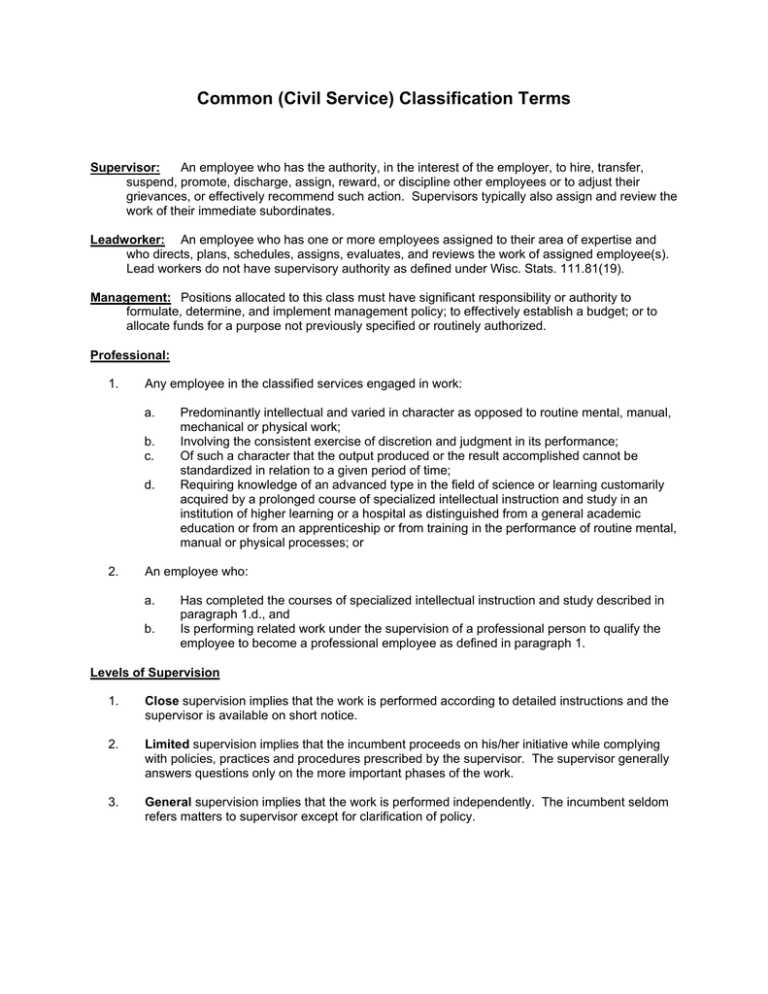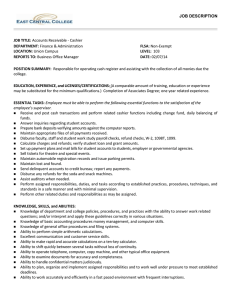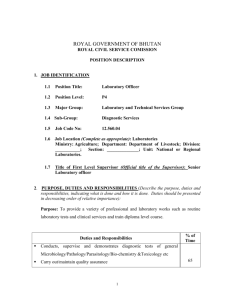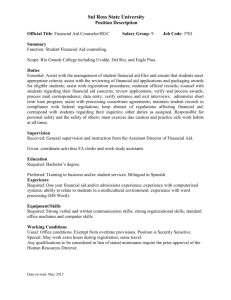Common (Civil Service) Classification Terms
advertisement

Common (Civil Service) Classification Terms Supervisor: An employee who has the authority, in the interest of the employer, to hire, transfer, suspend, promote, discharge, assign, reward, or discipline other employees or to adjust their grievances, or effectively recommend such action. Supervisors typically also assign and review the work of their immediate subordinates. Leadworker: An employee who has one or more employees assigned to their area of expertise and who directs, plans, schedules, assigns, evaluates, and reviews the work of assigned employee(s). Lead workers do not have supervisory authority as defined under Wisc. Stats. 111.81(19). Management: Positions allocated to this class must have significant responsibility or authority to formulate, determine, and implement management policy; to effectively establish a budget; or to allocate funds for a purpose not previously specified or routinely authorized. Professional: 1. Any employee in the classified services engaged in work: a. b. c. d. 2. Predominantly intellectual and varied in character as opposed to routine mental, manual, mechanical or physical work; Involving the consistent exercise of discretion and judgment in its performance; Of such a character that the output produced or the result accomplished cannot be standardized in relation to a given period of time; Requiring knowledge of an advanced type in the field of science or learning customarily acquired by a prolonged course of specialized intellectual instruction and study in an institution of higher learning or a hospital as distinguished from a general academic education or from an apprenticeship or from training in the performance of routine mental, manual or physical processes; or An employee who: a. b. Has completed the courses of specialized intellectual instruction and study described in paragraph 1.d., and Is performing related work under the supervision of a professional person to qualify the employee to become a professional employee as defined in paragraph 1. Levels of Supervision 1. Close supervision implies that the work is performed according to detailed instructions and the supervisor is available on short notice. 2. Limited supervision implies that the incumbent proceeds on his/her initiative while complying with policies, practices and procedures prescribed by the supervisor. The supervisor generally answers questions only on the more important phases of the work. 3. General supervision implies that the work is performed independently. The incumbent seldom refers matters to supervisor except for clarification of policy. 4. Direction – the employee usually receives only a general outline of the work to be performed and is free to develop own work sequences and methods within the scope of established policies. New, unusual or complex work situations are almost always referred to a supervisor for advice. Work is periodically checked for progress and conformance to established policies and requirements. Levels of Responsibility 1. Entry – The level of performance in a position at which the employee applies and develops basic skills in procedures, techniques, tools, materials, and/or equipment appropriate to the area of specialization. Duties and tasks are standardized. Performs some advanced functions as part of training development. Resolves routine questions and problems, and refers more complex issues to higher levels. 2. Developmental – An intermediate progression level in a classification series between the entry and objective levels. At a developmental level, the employee is given progressively more complex assignments and/or receives decreasing levels of supervision compared to the entry level. This process enables the employee to develop the competence necessary to function at full performance at the objective (or next developmental) level. 3. Objective – The classification level which any employee in any position allocated to that classification series, can reasonably expect to achieve. That maximum class level is then determined to be the objective level for all positions with similar duties and responsibilities, in that series, within the employing unit. 4. Full Performance (See: Objective) – The level of performance in a position at which the employee applies basic and some advanced skills in procedures, techniques, tools, materials, and/or equipment appropriate to the area of specialization. Duties and tasks are frequently non-routine, resolves most questions and problems, and refers only the most complex issues to higher levels. 5. Advanced – The level of performance in a position at which the employee applies sophisticated skills in the area of specialization. Knowledge has been acquired through additional training or years of actual experience. Problem solving and serving as a resource to others forms the majority of tasks. Resolves the most complex problems. 6. Senior (See: Advanced) – The level of performance in a position at which the employee applies advanced skills in the area of specialization. Adapts procedures, techniques, tools, materials, and/or equipment to meet special needs. Duties and tasks reflect substantial variety and complexity. Serves as a resource to others in the resolution of complex problems and issues. Level of Difficulty (of the work) 1. Routine – Refers to duties which regularly follow a prescribed or detailed course of action. Procedures are standardized and decisions follow customary practice or established rules. 2. Moderate – Means that the employee is confronted with a variety and breadth of duties susceptible to different methods of solution which in turn places a correspondingly higher demand on resourcefulness. Supervisors of employees engaged in routine assignments, journey level personnel and paraprofessional employees usually perform work of moderate difficulty. 3. Considerable – Refers to duties which require independent judgement; many factors must be considered and weighed before a decision can be reached. Usually positions requiring the planning, development or coordination of activities or programs or part thereof and the direction or coordination of employees fall into this category. Classification Factors 1. Accountability/Responsibility – Relates to the latitude to select alternatives and assign work or priorities, and finality of the decisions made. The discretion exercised is measured by evaluating the extent to which the work is structured or defined at the assignment stage and the nature of the review received both during and after completion of the work. Specific considerations are: a. the organizational level of the position; b. the nature and type of supervision received; c. the availability of other non-subordinate staff whose authority it is to make the most difficult and unprecedented program or technical decisions or interpretations; d. the degree of impact decisions and work efforts have on end results; and e. the consequence of error. 2. Complexity/Scope – Considers the nature, number, variety and intricacy of tasks, steps, processes, or methods in the work performed; the degree to which actions to be taken are preestablished or standardized; the number and variety of tasks needed to accomplish each goal; and the effect of the work product or service both within and outside the organization. Some specific considerations are: a. the number and nature of technologies for which the position is responsible; b. the degree to which duties can be performed while the equipment is off-line; c. the degree of problem definition received and the availability and applicability of established guidelines, routines, procedures, etc.; and d. the extent of the area of impact. 3. Knowledge – The breadth and depth of the knowledge and skills required to perform the work. a. Working Knowledge – implies sufficient knowledge of the subject to enable the employee to work effectively in a limited range of work situations; b. Considerable Knowledge – implies enough knowledge of the subject to enable the employee to work effectively in a wide range of work situations and with little direct supervision; c. Extensive Knowledge – implies an advanced knowledge of the subject matter so as to permit solution of unusually difficult work problems or issues, and advising on technical questions and planning methods for resolving these problems or issues; d. Thorough Knowledge – implies an unusually specialized in-depth knowledge, which calls for an almost complete mastery of the subject. 4. Miscellaneous Factors – a. the nature and level of internal and external coordination and communication required to accomplish objectives; b. the risks and discomforts in the employee’s physical surroundings and the nature of the work as characterized by the safety regulations which must be observed. This factor ranges from situations where everyday risks, which require normal safety precautions to situations where the work environment involves high risks with exposure to potentially dangerous situations or unusual environmental conditions.


